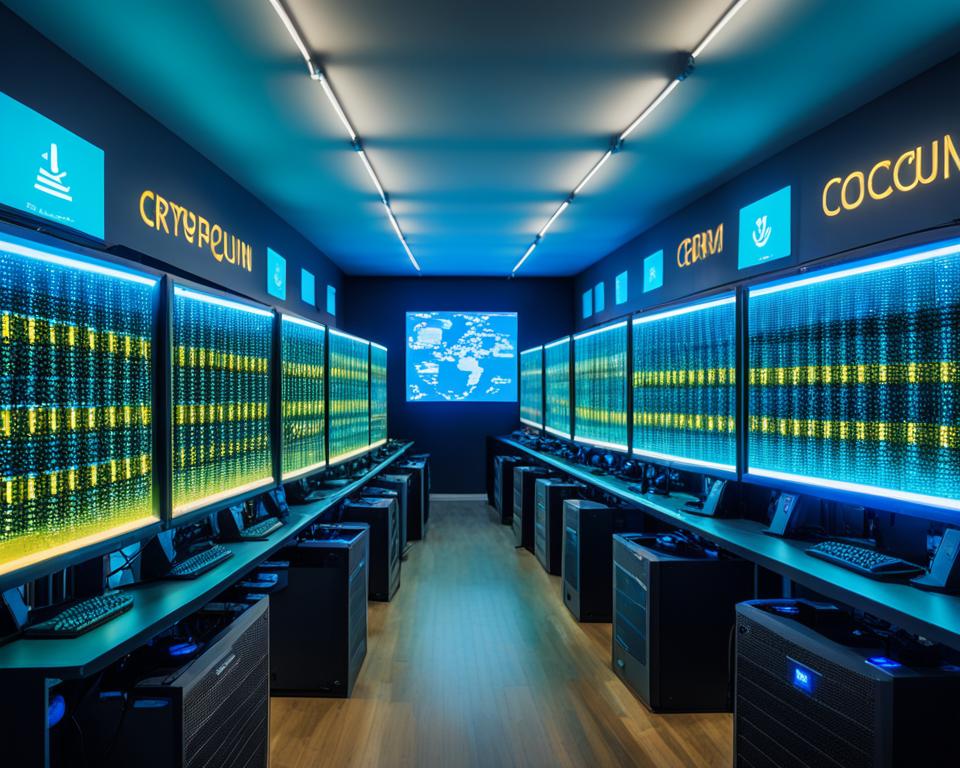Crypto Mining: Unlock the Potential of Digital Currency

Cryptocurrency mining is the process of verifying and adding transactions to a blockchain, the distributed digital ledger that underpins cryptocurrencies like Bitcoin. By participating in the mining process, you can earn digital currency rewards, making it an attractive way to get involved in the world of cryptocurrencies. In this article, you’ll explore the fundamentals of crypto mining, the different types of mining methods, and the steps to set up your own mining rig for profitable crypto mining.
Key Takeaways
- Crypto mining is the process of verifying and adding transactions to a blockchain, the distributed digital ledger that underpins cryptocurrencies.
- By participating in the mining process, you can earn digital currency rewards, making it an attractive way to get involved in the world of cryptocurrencies.
- GPU mining and ASIC mining are the two primary types of crypto mining methods.
- Setting up a profitable mining rig involves choosing the right hardware, joining a mining pool, and considering various mining profitability factors.
- The proof of work consensus mechanism and blockchain technology are crucial to the functioning of the cryptocurrency mining process.
Crypto Mining: A Revolutionary Way to Earn Digital Currency
Cryptocurrency mining is a crucial component of the blockchain technology that powers digital currencies like Bitcoin and Ethereum. Through the mining process, powerful computers, known as miners, validate and add transactions to the blockchain, ensuring the integrity and security of the network. As a reward for their efforts, miners are compensated with newly created cryptocurrency tokens, making crypto mining a revolutionary way to earn digital currency.
Understanding the Basics of Cryptocurrency Mining
At the heart of cryptocurrency mining is the process of verifying and adding transactions to the blockchain, the distributed digital ledger that forms the backbone of digital currencies. Miners employ high-powered computers to solve complex mathematical problems, a process known as proof of work. By successfully validating a block of transactions, miners are rewarded with newly minted cryptocurrency, providing an incentive for them to participate in the network and maintain its security.
The Role of Mining in Blockchain Technology
The blockchain technology that underpins cryptocurrencies is a revolutionary innovation that has far-reaching implications beyond just digital currencies. By leveraging the power of distributed ledgers, blockchain ensures the transparency, immutability, and security of transactions, making it a game-changer in various industries, from finance to supply chain management. The crypto mining process is integral to this technology, as it provides the computational power necessary to validate and record transactions, ultimately maintaining the overall integrity of the cryptocurrency network.

Different Types of Crypto Mining
The world of crypto mining offers two primary avenues for enthusiasts and investors to explore: GPU mining and ASIC mining. Each method presents its own unique advantages and considerations, allowing you to tailor your approach to your specific needs and goals.
GPU Mining: Harnessing the Power of Graphics Cards
GPU mining, also known as graphics processing unit (GPU) mining, leverages the computational power of high-performance graphics cards to solve the complex mathematical problems that underpin the mining process. This approach is particularly appealing for individual miners or small-scale operations, as GPUs are relatively accessible and can be used to mine a wide range of cryptocurrencies, including GPU mining favorites like Ethereum and Monero.
ASIC Mining: Specialized Hardware for Efficient Mining
In contrast, ASIC mining involves the use of application-specific integrated circuits (ASICs) designed specifically for the task of crypto mining. These specialized mining rigs are engineered to excel at the specific algorithms used by various cryptocurrencies, often outperforming GPUs in terms of efficiency and processing power. While ASIC miners tend to be more expensive upfront, they can offer higher potential returns for large-scale mining operations.

Regardless of which path you choose, understanding the nuances of GPU mining and ASIC mining will be crucial in your pursuit of profitable and sustainable crypto mining. Carefully evaluate your available resources, investment goals, and the specific requirements of the cryptocurrencies you wish to mine to determine the most suitable approach for your needs.
Setting Up Your Mining Rig
To set up your mining rig, you’ll need to carefully select the right mining hardware. Whether you opt for GPU mining or ASIC mining, it’s crucial to research the latest and most efficient models on the market. Consider factors like hash rate, power consumption, and cost-effectiveness to ensure your mining setup is optimized for profitability.
Choosing the Right Mining Hardware
When it comes to mining rigs, your choice of hardware can significantly impact your mining profitability. Carefully evaluate the performance and energy efficiency of different GPUs or ASIC miners to determine the best fit for your needs and budget. Stay up-to-date with industry trends and advancements to make an informed decision that will maximize your mining returns.
Mining Pools: Strength in Numbers
Joining a mining pool can be a strategic way to increase your chances of earning consistent cryptocurrency rewards. By pooling your computing power with other miners, you can collectively tackle the complex mathematical problems required for mining, and share the rewards proportionally. Research reputable mining pools, their fee structures, and the specific cryptocurrencies they support to find the right fit for your mining operation.
Mining Profitability: Factors to Consider
Evaluating the profitability of your mining efforts is crucial for long-term success. Factors like the cryptocurrency’s current value, network difficulty, and your electricity costs can all impact the financial viability of your mining rig. Keep a close eye on these variables and be prepared to adjust your strategy as needed to maintain a profitable mining operation.




